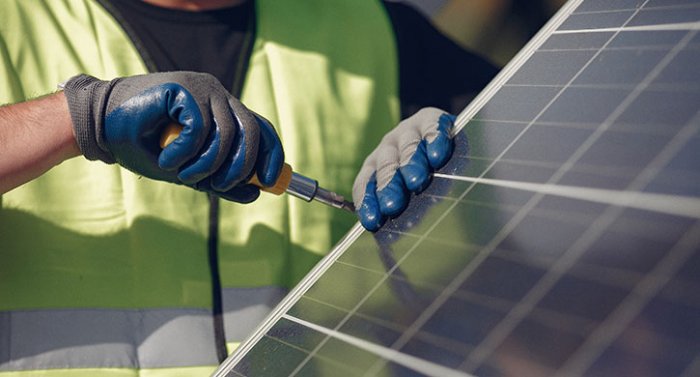
Innovation can help combat rising temperatures on the planet. Orange has invested in this lever via an ambitious plan to reduce its own carbon footprint. The Group is committed to achieving net zero carbon emissions by 2040, ten years ahead of targets set by the rest of the sector. This objective is in line with Orange's initial ambition set out in 2015 during the Paris Agreement on climate change.
To achieve its environmental objective, Orange is following a strict energy efficiency policy, increasing its consumption of renewable energy, developing the circular economy, and investing in carbon capture solutions to reduce residual emissions.
Despite the exponential increase in data on its networks, Orange has defined an ambitious roadmap, with a first step in 2025 to reduce CO2 emissions by 30% on scopes1 1 and 2 compared to 2015. Similarly, Orange is committed to increasing the share of renewable energies, with the goal of reaching 50% of electricity from renewable sources in the Group's energy mix by 2025, and to continue improving the efficiency of its networks and buildings. In addition, Orange has undertaken to reduce its type 3 emissions by 14% by 2025. To achieve this objective, commitments have been made throughout the company to reduce the direct or indirect environmental footprint.
Green IT & Networks action plan
Orange continually seeks to improve the energy efficiency of its networks through the Green IT & Networks plan, which aims to optimize its technical deployments, increase the eco-efficiency of its data centers, and reduce the energy consumed by routers. Since 2010, this program has significantly reduced the Group's energy consumption and associated carbon emissions.
Some actions involve replacing old infrastructure with modern and eco-efficient equipment using alternative solutions such as natural ventilation or solar energy. Examples include the Val-de-Reuil data center and the new Orange data center near Chartres, in France.
In Africa and the Middle East, Orange MEA already uses 2,800 solar sites to power the mobile network, thereby saving fuel used by diesel generators where the electricity network is not available. To give another example, in Jordan, Orange has set up three solar farms, which cover 73% of the network’s needs. This program avoided CO2 emissions of 18% in 2020 compared to 2019.
A member of the Net Zero carbon by 2040 initiative, Orange Networks has deployed a new Energy Action Plan, with 2015 as the reference year.
Energy Action Plan (EAP) is a Group program designed to help Orange countries in their energy transformation, by mitigating increased energy expenditure and reducing CO2 emissions. The EAP is supported by the energy saving levers in the Green ITN portfolio – an online booklet containing the description of some 50 green levers. The portfolio provides a brief and illustrative overview of the Group’s technical solutions that improve the energy efficiency of its ITN infrastructures, including the network, IT, software and architectures.
This portfolio helps subsidiaries meet the objectives of the Group's Engage 2025 plan in terms of corporate social responsibility, for which they are responsible.
Each year, the portfolio of green levers is reviewed and updated by Orange experts, based on proof of concepts, tests, and collaborations with Orange suppliers and affiliates. The levers are split into 4 categories: Technical environment, Radio Access Network (RAN), Fixed Access Network, and IT purchase categories.
The focus is on energy saving functions for mobile networks in the RAN category. The most important drivers contributing to the reduction of CO2 emissions include the decommissioning of unused equipment, solarization of remote sites, IT optimization, renewal and sharing of the RAN, energy meters, and green energy contracts.
Orange Networks tests and deploys a broad range of new levers such as liquid cooling, solarization and, in the RAN domain, the enhancement of architectures such as full fiber access, etc.
In addition, new levers based on the energy of Big Data and Artificial Intelligence (AI) are emerging. AI research and applications have proliferated in recent years with the use of Machine Learning (ML) and neural networks. AI has been successfully applied in many areas, including telecommunications. Orange Research indicates that AI and ML could achieve an energy saving of 15%.
The energy saving of networks through AI can be split into different phases:
- Definition of use cases: defining the basic problems to be solved and the necessary data to be collected.
- Data collection: depending on the use cases, specific equipment may need to be installed to collect data that is not already available, e.g. temperature, humidity, fuel levels, etc.
- Design and assessment: AI is used to analyze use cases and pre-evaluate the benefits of energy savings as well as the basic impact of the energy saving solution on QoS indicators.
- Implementation of the solution across the network and monitoring of key network indicators to ensure that QoS is not affected.
Sample use case: optimizing the energy efficiency of sites
When telecommunications networks are installed, they are usually configured with predefined settings such as the number of cells and frequency bands, in order to meet a predetermined level of QoS.
Oversizing has long been considered one of the main levers to ensure good QoS. As a result of massive and continuous investments, the capacity of our networks has constantly evolved to ensure solid performance in critical situations, such as peak periods or festivals, football matches, etc. The disadvantage of this policy is that it has progressively led to an ever higher demand for energy, regardless of the average traffic to be delivered. In addition, over time, subtle site changes and settings can result in different energy consumption levels and, as a result, some sites may consume much more energy than others for the same amount of traffic.
Recently, a case study was launched in two Orange subsidiaries. Massive data was collected from the operational networks. An AI engine subsequently analyzed thousands of radio sites, taking into account their main characteristics such as technology, traffic provided per hour, the corresponding energy consumption per module, average flow rate of users, etc. The goal was to assess each radio site's energy efficiency compared with the traffic delivered by technology, and to detect atypical sites which, although providing exactly the same amount of traffic and delivering the same QoS, consumed up to 4 times more energy than a radio site with similar characteristics.
The analysis showed that 30% of radio sites could be partially reduced during certain periods of low traffic. This could result in a reduction in RAN energy consumption of more than 5%.
Based on this study, Orange has built an "AI-based recommendation engine" capable of analyzing an entire mobile network and producing a set of sites with optimization recommendations to be validated and implemented by the network engineer. These recommendations guarantee a significant reduction in energy consumption without impacting service quality.
Taking into account the complete energy action plan, all Orange countries have signed up to this program, each deploying some twenty levers on average.
From 2015 to 2020, the joint efforts of the Orange Networks and the Group's Countries saved
3.4 TWh of electricity, and 191 million liters of fuel representing 3.36 megatonnes of CO2 emissions saved in our ITN networks. This amount of CO2 saved is equivalent to the annual emissions of a country like Mauritius.
Written by Stefania Nicoleta Dragomir; Taoufik En Najjary; Lionel Dubois
1 Scopes 1 and 2: CO2 emitted by Orange networks, data centers and real estate during operation




